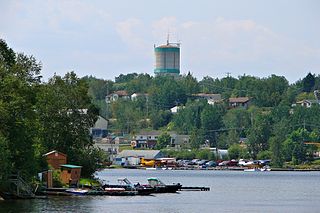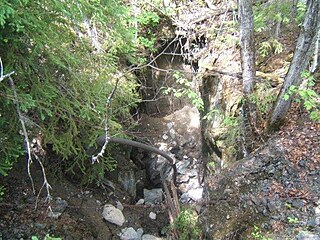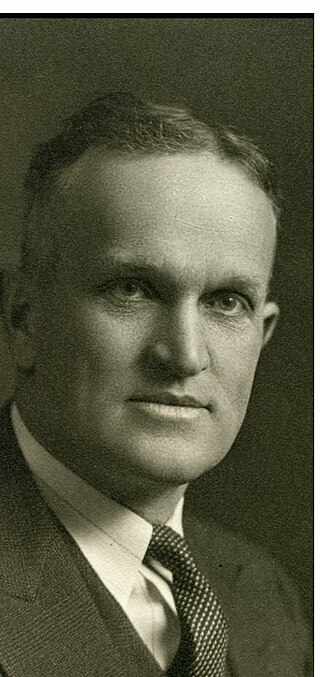
Mining is the extraction of valuable geological materials and minerals from the surface of the Earth. Mining is required to obtain most materials that cannot be grown through agricultural processes, or feasibly created artificially in a laboratory or factory. Ores recovered by mining include metals, coal, oil shale, gemstones, limestone, chalk, dimension stone, rock salt, potash, gravel, and clay. The ore must be a rock or mineral that contains valuable constituent, can be extracted or mined and sold for profit. Mining in a wider sense includes extraction of any non-renewable resource such as petroleum, natural gas, or even water.

Underground hard-rock mining refers to various underground mining techniques used to excavate "hard" minerals, usually those containing metals, such as ore containing gold, silver, iron, copper, zinc, nickel, tin, and lead. It also involves the same techniques used to excavate ores of gems, such as diamonds and rubies. Soft-rock mining refers to the excavation of softer minerals, such as salt, coal, and oil sands.

Open-pit mining, also known as open-cast or open-cut mining and in larger contexts mega-mining, is a surface mining technique that extracts rock or minerals from the earth.
Wesdome Gold Mines Ltd. is a mining, exploration and development company based in Toronto, Ontario, focused primarily on gold.

Red Lake is a municipality with town status in the Canadian province of Ontario, located 535 km (332 mi) northwest of Thunder Bay and less than 100 km (62 mi) from the Manitoba border. The municipality consists of six small communities—Balmertown, Cochenour, Madsen, McKenzie Island, Red Lake and Starratt-Olsen—and had a population of 4,107 people in the Canada 2016 Census.

The Temagami Greenstone Belt (TGB) is a small 2.7 billion year old greenstone belt in the Temagami region of Northeastern Ontario, Canada. It represents a feature of the Superior craton, an ancient and stable part of the Earth's lithosphere that forms the core of the North American continent and Canadian Shield. The belt is composed of metamorphosed volcanic rocks that range in composition from basalt to rhyolite. These form the east-northeast trend of the belt and are overlain by metamorphosed sedimentary rocks. They were created during several volcanic episodes involving a variety of eruptive styles ranging from passive lava eruptions to viscous explosive eruptions.

Beanland Mine, also known as Clenor Mine, is an abandoned surface and underground mine in Northeastern Ontario, Canada. It is located about 1 km (0.62 mi) west of Arsenic Lake and 4 km (2.5 mi) northwest of the town of Temagami in central Strathy Township. It is named after Sydney Beanland, who first claimed the mine site in the 1920s and was a director for the mine from 1937 to 1938.

The Red Lake mine was one of the largest gold mines in Canada and in the world. The mine is located in northwestern Ontario at Red Lake. The mine had estimated reserves of 3.23 million oz of gold in 2013. Note that the Campbell and Red Lake mines are mining the same orebody, commonly referred to as the Campbell-Red Lake deposit.

Big Dan Mine is an abandoned underground mine in Northeastern Ontario, Canada. It is located about 1 km (0.62 mi) southwest of Net Lake and just west of the Ontario Northland Railway in east-central Strathy Township. It is named after Dan O'Connor, who first claimed the site in the 1890s.

Orex Exploration is a former Canadian gold mining company that conducted exploration work on mining properties it owned in the Goldboro and Guysborough County areas of Nova Scotia. The properties owned by Orex were the sites of the former Boston Richardson Mine, Dolliver Mountain Mine, West Goldbrook Mine, and East Goldbrook Mine which operated between 1892 and 1912. Headquartered in Rouyn-Noranda, Quebec, the company was founded in 1987 and raised funds for exploration work, in part, by issuing stocks traded on the Montreal Stock Exchange and then the TSX Venture Exchange. It became a subsidiary of Anaconda Mining Inc. after Anaconda acquired the company in a stock swap deal in 2017.
Priest Mine is an abandoned surface and underground mine in Northeastern Ontario, Canada. It is located about 19 km (12 mi) northwest of the hamlet of Marten River on an island in north-central Cross Lake. Dating back to the early 1900s, it is one of the oldest mines in the municipality of Temagami.

The Musselwhite mine is one of the largest gold mines in Canada and in the world. The mine is located in the centre of the country in Ontario. The mine has estimated reserves of 2.29 million ounces (65 t) of gold.
The Omai Gold Mine is located in Guyana on the north coast of South America near the west bank of the Essequibo River in the interior of the country. Access to Omai is by road from the capital of Georgetown on the coast, and from the town of Linden approximately 60 km away. There is an operational airstrip on site which can accommodate aircraft from Georgetown. Gold mining at Omai is known from at least the 1880s, and when it was developed as a large scale mine in 1992 by Cambior, the mine was the largest gold mine in the Guiana Shield and a major source of income and employment in Guyana. During the period from 1992 – 2005, Omai produced 3.7 Moz of gold at an average grade of 1.5 g/t Au from the Fennell and the Wenot open pits.
The Agnew Lake Mine was a uranium mine located in the township of Hyman approximately 10 kilometres (6.2 mi) northeast of Agnew Lake, Ontario and 75 kilometres (47 mi) east of Elliot Lake, Ontario.

Greenside Mine was a successful lead mine in the Lake District of England. Between 1825 and 1961 the mine produced 156,000 long tons of lead and 1,600,000 ounces of silver, from around 2 million tons of ore. During the 1940s it was the largest producer of lead ore in the UK. Unusually for a 19th-century metalliferous mine in Britain there are very full records of its activities, dating back to 1825.

Karl Brooks Heisey was a Canadian mining engineer and mining executive in the 1930s. Heisey pioneered the exploration and development of the Sanshaw/Red Lake metal deposits located in northwest Ontario. The Red Lake Mine is one of the richest gold mines in the world, still in production today with annual production of 600,000 ounces gold and over 11 million ounces produced to date.

Osisko Gold Royalties Ltd is a Canadian company that holds royalties in gold, silver and diamond mines, principally in the form of net smelter returns and streams. The company also invests in mineral exploration companies in the form of purchases of shares. Like its predecessor company, Osisko Mining, it is headquartered in Montreal, Quebec, with shares listed on the Toronto Stock Exchange and the New York Stock Exchange.

Uranium mining around Bancroft, Ontario, was conducted at four sites, beginning in the early 1950s and concluding by 1982. Bancroft was one of two major uranium-producing areas in Ontario, and one of seven in Canada, all located along the edge of the Canadian Shield. In the context of mining, the "Bancroft area" includes Haliburton, Hastings, and Renfrew counties, and all areas between Minden and Lake Clear. Activity in the mid-1950s was described by engineer A. S. Bayne in a 1977 report as the "greatest uranium prospecting rush in the world".
Gordon Lake Mine was an underground copper mine near Werner Lake in the Kenora District of Ontario Canada.

The Kerr–Addison Mine is an abandoned Canadian gold mine in the Kearns area of McGarry, Ontario. In 1960, the mine was the largest producer of gold in North America. The mine produced the second most gold overall in North America, with the Homestake Mine being the leader.





























